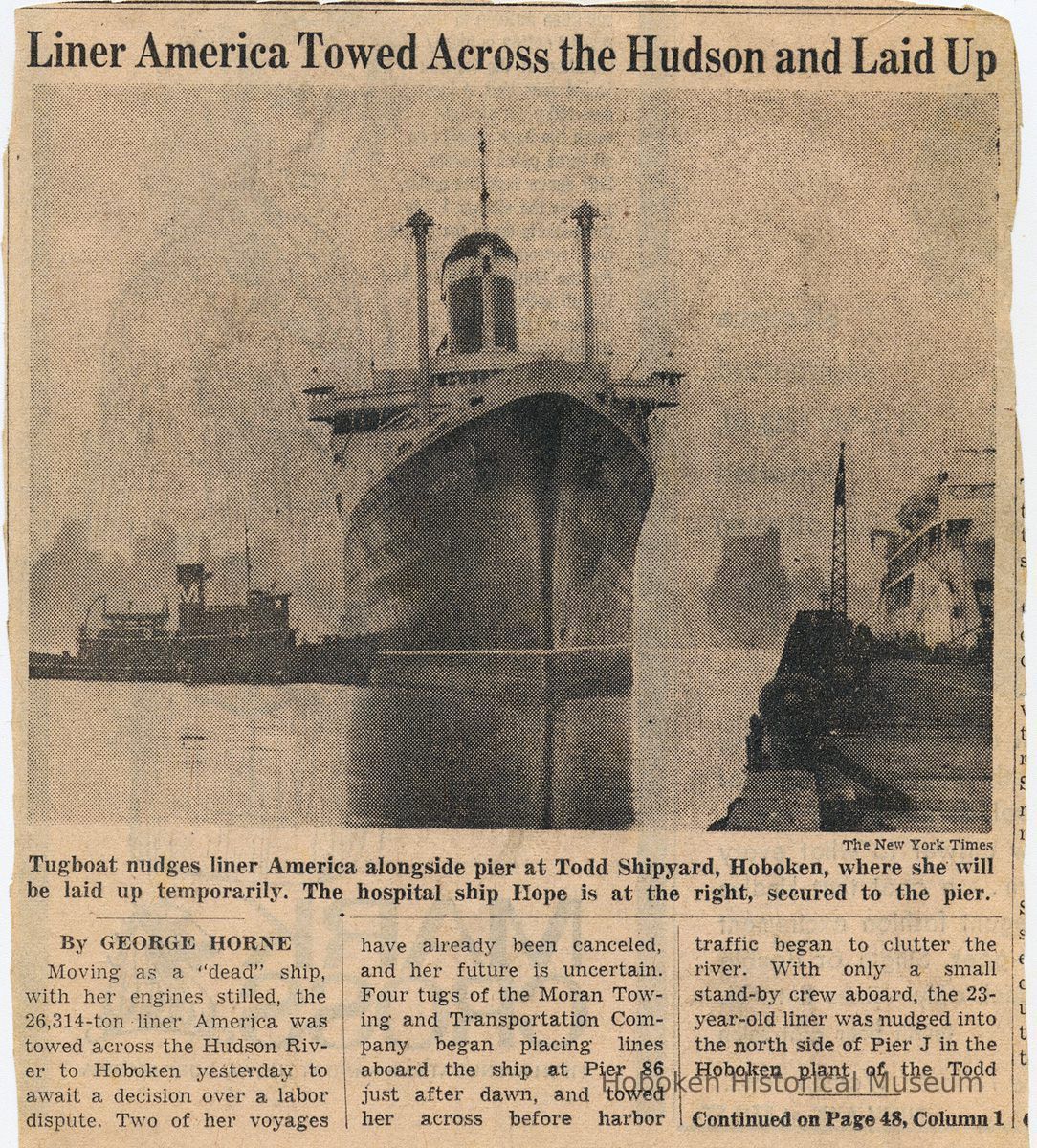Article: Liner America is Towed Across the Hudson and Laid Up. NYT, Sept. 29, 1953. With two other articles.
2012.001.0033
2012.001
Purchase
Purchase
Museum Collections.
1963 - 1963
Date(s) Created: 1963 Date(s): 1963
Notes: 2012.001.0033. Article 1: The New York Times, Sunday, September 29, 1963 Liner America Towed Across the Hudson and Laid Up [caption] Tugboat nudges liner America alongside pier at Todd Shipyard, Hoboken, where she will be laid up temporarily. The hospital ship Hope is at the right, secured to the pier. By GEORGE HORNE Moving as a "dead" ship, with her engines stilled, the 26,314-ton liner America was towed across the Hudson River to Hoboken yesterday to await a decision over a labor dispute. Two of her voyages have already been canceled, and her future is uncertain. Pour tugs of the Moran Towing and Transportation Company began placing lines aboard the ship at Pier 86 just after dawn, and towed her across before harbor traffic began to clutter the river. With only a small stand-by crew aboard, the 23-year-old liner was nudged into the north side of Pier J in the Hoboken plant of the Todd Continued on Page 48, Column 1 48 THE NEW YORK TIMES, SUN[DAY, SEPTEMBER 29, 1963.] AMERICA IS TOWED ACROSS THE RIVER Continued From Page 1, Col. 5 Shipyards Corporation, where she will be laid up for the time being. The 662-foot liner was tied up before 7:30 A.M. She was handled by the tugs Kerry Moran, Alice Moran, Moira Moran and Cynthia Moran. She was berthed across the pier from the hospital ship Hope, which has been idle in the Todd layup yard since she made a world cruise dispensing American aid and goodwill in ports of underprivileged nations. Some of the America's crew will remain aboard during her layup, to maintain ship safety. The majority of the vessel's 650-man crew has been out of work since her Sept. 14 sailing was canceled after a demand of the unlicensed men of the crew — represented by the National Maritime Union — for the dismissal of the ship's first assistant engineer, Louis Neurohr. Some of the unlicensed seamen charged that Mr. Neurohr had used racist epithets against them, had interfered with seamen not under his jurisdiction and had irritated and annoyed crew members. More than 900 passengers were forced to find other means of transportation to Europe when the line called off the cruise. While the United States Lines ship waits, the case against Mr. Neurohr will be heard under an arbitration proceedings of his union, the Marine Engineers Beneficial Association. Donald F. Shaughnessy, the permanent arbitrator under the contracts between the union and the shipping industry, will preside at the hearing, which will start at 10:30 A.M. tomorrow, at M.E.B.A. headquarters at 17 Battery Place. The request for the action was made by the American Merchant Marine Institute, a trade organization that bargains labor contracts for a major segment of the shipping industry. The shipping industry,, has condemned the N.M.U. charges against the engineer as a subterfuge- The two unions have been at loggerheads for years— a split that has been blamed for much of the industry's labor turmoil. The unlicensed seamen's union and the industry have their own arbitration process, with Theodore W. Kheel as the permanent arbitrator. Mr. Kheel heard the case after the Sept. 14 cancellation and issued two orders, one for the union to send its men back to the ship and one for the company to remove the cause of the trouble. While the latter was an indirect order, the company did take Mr. Neurohr off the ship, an action protested by the engineer union. With the issue thus unsettled, the United States Lines withdrew the America's next sailing, an Oct. 24 cruise. It has been estimated that the crew has lost around $700,000 in wages. The line has lost more than $1,000,000 in gross revenues. Last week Mr. Kheel and Joseph Curran, president of the National Maritime Union, called for some kind of new arbitration set-up that would take care of disputes that cross the "no-man's land" between two union jurisdictions. The uncertainty about the America's future is based on her j age. Under subsidy contracts; between a steamship line and the Government, a ship is earmarked for replacement after she is 20 years old—an age of obsolescence. The America is now operating under a waiver permitting her to go beyond the retirement age. [end article 1] ---- Article 2: Sunday News (Daily News), Sunday, September 29, 1963 4 Sunday News, September 29, 1963 Moving to Sidelines in Labor Dispute (NEWS foto by Jerry Kinstler) [caption] The America starts out from Pier 86, Hudson River, for Hoboken shipyard. Her engines stilled, her future uncertain, the 26,314-ton liner America was towed across the Hudson River from Pier 86, W. 46th St., to the Todd Shipyards in Hoboken yesterday. There she will await resolution of a labor dispute that already has canceled two sailings, at a loss of more than $1 million to her owners, the United States Lines, and a loss of $700,000 to her crew in wages. The dispute centers on the demand of some of the crew, represented by the National Maritime Union, that Louis Neurohr, first assistant engineer, be fired for alleged racial bias. Neurohr is a member of the Marine Engineers Beneficial Association, long at loggerheads with the NMD. The 662-foot America is 23 years old, past the age of obsolescence, and a long tieup could end her sea days. [end article 2] Article 3: (New York World-Telegram and Sun), ca. late Dec. 1963. Photo by Ravenna After being idle for three months at a Hoboken pier, the liner America is moved across the Hudson to her regular berth at Pier 86. The 33,961-ton vessel, the nation's second largest passenger ship, will be overhauled at Newport News, Va., and make her next trans-Atlantic sailing Feb. 7. [end article 3] Status: OK Status By: dw Status Date: 2012-05-29






